ECON1210 Introductory Microeconomics Final Examination August 22, 2021
Hello, dear friend, you can consult us at any time if you have any questions, add WeChat: daixieit
ECON1210 Introductory Microeconomics
Final Examination
Date: August 22, 2021, 14:30-16:30 (+ 15 minutes of grace period)
1. My university ID number is [ Answer01 ].
2. The equation below shows Ben’s benefit of consuming n cups of tea and tea is perfectly divisible and can be consumed at any arbitrary quantity (say, 3.14 cups).
Total benefit (HKD): T B(n) = 188n − 10n2
Average benefit (HKD): AB(n) = 188 − 10n
Marginal benefit (HKD): MB(n) = 188 − 20n
Suppose the price is HKD 24 per cup. Ben’s economic surplus from consuming tea would be HKD [ Answer02 ].
The government hires workers to give vaccine doses at three Community Vaccination Centers: “CVC-A”, “CVC-B” and “CVC-C”. The major decision is the allocation of the workers among the three CVCs, so as to maximize the amount of doses given. The following table shows the amount of doses that will be given in these CVCs as a function of the number of workers deployed. For instance, when 2 workers are sent to CVC-C, a total of 460 doses will be given there.
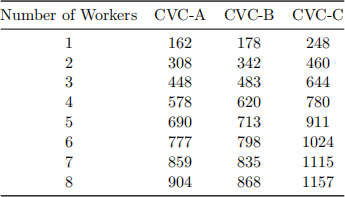
3. Suppose 8 workers are hired. To maximize the number of doses given, the government should allocate [ Answer03A ] workers to CVC-A, [ Answer03B ] workers to CVC-B, and [ Answer03C ] workers to CVC-C.
4. Now suppose the government wants to give at least 1712 doses. Suppose the government always allocates the N workers among the three CVCs to maximize the amount of doses given. According to the government’s allocation rule, in order to given at least 1712 doses, N must be at least equal to [ Answer04 ].
Robinson and Friday are the only people on Despair, a small island. They both produce grain and meat. Let G denote the quantity of grain, and M denote the quantity of meat. The following equations summarize their production possibility curves (PPCs) per week.
Robinson: G = 18 − 6M
Friday: G = 72 − 4M
5. Suppose Despair is a closed economy. If Robinson and Friday would like to jointly consume 5 units of meat per week, they would be able to jointly consume a maximum of [ Answer05 ] units of grain per week.
6. In this closed economy, any admissible terms of trade between Robinson and Friday have to be larger than [ Answer06A ] units of grain per unit of meat and smaller than [ Answer06B ] units of grain per unit of meat.
7. Suppose Despair is now opened up to trade with the rest of the world, and can trade at world terms of trade of 1.5 units of grain per unit of meat. If Robinson and Friday would like to jointly consume 5 units of meat per week, they would be able to jointly consume a maximum of [ Answer07 ] units of grain per week.
8. The United Kingdom and Germany trade cars and trucks. The United Kingdom can produce one car with 50 man hours, and one truck with 140 man hours. Germany can produce one car with 30 man hours, and one truck with 102 man hours. You are on the United Kingdom team bargaining over the terms of trade under a new trade deal. You inform your team that the best terms of trade the UK can reasonably ask for are [ Answer08A ] cars per truck and the worst terms of trade the UK can accept are [ Answer08B ] cars per truck.
There are two groups of consumers, A and B, with the following demand relations, respectively:
Demand A: P = 126 − QA
Demand B: P = 63 − QB
The market supply is
P = 0.5Q
9. Given this information, we can compute that the market equilibrium price is [ Answer09A ] and the market equilibrium quantity is [ Answer09B ].
10. The total consumer surplus at the equilibrium is [ Answer10 ].
11. How many of the following statements are correct?
(i) If income decreases, the demand curve of a normal good shifts leftward.
(ii) Starting from the unregulated market equilibrium, assuming an upward sloping linear supply and a downward sloping linear demand, consumer surplus sometimes increases and sometimes decreases when the price is set below the equilibrium price.
(iii) Starting from the unregulated market equilibrium, assuming an upward sloping linear supply and a downward sloping linear demand, consumer surplus always decreases when price is set above the equilibrium price.
(iv) The supply curve shows the maximum price suppliers must receive in order to produce an additional unit of the good.
A) 0
B) 1
C) 2
D) 3
E) 4
[ Answer11 ]
12. The enthusiasm of Utopian travelers for Japan has experienced a record low recently due to a recent pandemic. Suppose the exchange rate was 13.5 yen per Utopian currency before the pandemic. Other things being equal, how many of the following exchange rates (yen per Utopian currency) are more likely to prevail now?
9.5 10.5 13.5 12.5
A) 0
B) 1
C) 2
D) 3
E) 4
[ Answer12 ]
13. Wineries make wine from grapes. In making wine, the wineries produce grapeseed oil as a by-product. This oil is then used to cook and bake. How many of the following events would cause an increase in the supply of wine?
(i) The price of grapeseed oil falls.
(ii) The price of wine rises.
(iii) A report shows the consumption of wine would increase the average happiness of parents and health-care experts advise parents to drink more wine.
(iv) The wage rate of winery workers rises.
A) 0
B) 1
C) 2
D) 3
E) 4
[ Answer13 ]
14. Good X and good Y both use a common input Z for production. Suppose now we have PY = 18 and QY = 8. Given that an increase in demand in the market of X, other things being equal, which of the following price and quantity pairs (PY , QY ) can be true under the new equilibrium in the market of good Y?
A) (18,8)
B) (20,6)
C) (16,6)
D) (18,10)
E) None of the above
[ Answer14 ]
15. How many of the following statements are correct?
(i) If two linear demand curves have a point in common, the flatter curve must be more price elastic at that common point.
(ii) For a downward-sloping linear demand curve, as the price increases, the price elasticity of demand increases in magnitude (i.e., absolute values).
(iii) The price elasticity of demand ranges from 0 to infinity.
(iv) Inferior goods have a positive income elasticity of demand.
A) 0
B) 1
C) 2
D) 3
E) 4
[ Answer15 ]
16. In how many of the following product pairs is the demand for the first product likely more price elastic than that for the second product?
(i) Fancy coffee vs. Fancy cars
(ii) Multi-vitamin pills vs. life-saving drugs
(iii) Fish vs. salt
(iv) Apartments in Wan Chai vs. Apartments in Hong Kong
A) 0
B) 1
C) 2
D) 3
E) 4
[ Answer16 ]
17. At the market equilibrium, the price elasticity of demand is found to be −1.7; the price elasticity of supply is found to be 2. We predict that a small increase in supply will _____ the seller’s revenue, and a small increase in demand will _____ the seller’s revenue.
A) raise, raise
B) raise, lower
C) lower, raise
D) lower, lower
[ Answer17 ]
The demand curve for asparagus takes the form of
QA = 1770 − 2PA − 0.5PB
where PA is the price of asparagus, and PB is the price of beans. At one equilibrium, QA = 4.47 and the cross-price elasticity between asparagus and beans is −3.4.
18. Then we can compute that PB = [ Answer18 ] at the equilibrium.
19. We can further compute that PA = [ Answer19 ]
20. At the current equilibrium point, the price elasticity of demand for soda is −0.7 and the price elasticity of supply for soda is 1.67. Suppose the demand decreases by 2.5%. This leads to a decrease of [ Answer20A ]% in the equilibrium price and a decrease of [ Answer20B ]% in the equilibrium quantity.
21. At a gas station, the clerk of the only convenience store found that he can sell 127 packs of chewing gum when the price is $2.3 and 86 packs of chewing gum when the price is $5.9. Suppose the demand for chewing gum is linear and downward sloping, and the clerk has been instructed by his boss to set the price to maximize revenue. Given this instruction, he should set the price at $[ Answer21A ] per pack and sell a total of [ Answer21B ] packs.
22. The supply curve is linear and upward sloping and the demand curve is linear and downward sloping. How many of the following statements is/are TRUE?
(i) Consider a per unit tax. If buyers are more price elastic than sellers, buyers will bear more burden of the tax.
(ii) For the same amount of tax per unit imposed, deadweight loss is greater when the demand and/or supply is more price elastic.
(iii) Consider an introduction of a per unit tax. When demand and supply are both price inelastic at the initial equilibrium, the decrease in total economic surplus received by consumers and producers is less than the gain in tax revenue received by the government.
(iv) If the government levies a tax of 1 dollar for each unit of a good, the price of the good paid by the buyers increases by less than 1 dollar.
A) 0
B) 1
C) 2
D) 3
E) 4
[ Answer22 ]
23. The government decides to subsidize the solar panels industry to encourage the adoption of solar panels and enhance its competitiveness. They decide to subsidize the producers by $21 for every unit of solar panel they produce. The demand and supply curves are
Demand Qd = 500 − 4.5P
Supply Qs = 5P
As a result of the subsidy, buyers will pay $[ Answer23A ] less per unit. At the same time, the sellers will receive $[ Answer23B ] more per unit.
Consider the following supply and demand schedule for college education.
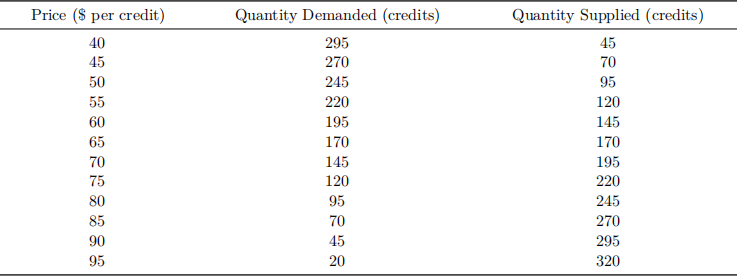
24. Suppose initially the college education market is in an unregulated equilibrium. If the government imposes on sellers a tax of $30 for each credit sold, the new equilibrium price paid by the consumers will be $[ Answer24 ].
25. Given the above information, the government’s tax revenue will be $[ Answer25 ].
26. Suppose initially the college education market is in an unregulated equilibrium. If the government imposes on sellers a subsidy of $10 for each unit of the credit sold, the new equilibrium quantity would be [ Answer26 ] units.
27. The following equations describe the demand and supply of the market for taxi services in Utopia.
Demand: P = 200 − 5Qd
Supply: P = 20 + 4Qs
where P is the taxi fare ($/km), Qd and Qs are quantity demanded and quantity supplied respectively.
How many of the followings can happen if the government decides to set a price floor at $99?
(i) The quantity supplied for taxi services will increase.
(ii) The quantity demanded for taxi services will increase.
(iii) The demand for taxi services will decrease.
(iv) The taxi fare would become higher.
A) 0
B) 1
C) 2
D) 3
E) 4
[ Answer27 ]
The residents of Vancouver complain to the government that rent (dollars per square foot) is too high. The administration promises to consider a rent control policy proposed by residents. The market demand and supply curves of rental property are given by the following equations.
Demand: Q = 200 − 1.4P million square feet
Supply: Q = 2P million square feet
28. Consider a price ceiling on rent at 29 dollars per square foot. At this price ceiling, there will be a shortage of [ Answer28 ] million square feet.
29. At this proposed price ceiling, producer surplus is expected to be [ Answer29A ] million dollars per year and the maximum possible consumer surplus will be [ Answer29B ] million dollars per year.
Suppose there are 7 persons in the economy with the following willingness to pay for a good.
$16 $14 $12 $10 $8 $4 $2
30. At the price ceiling of $2, only 3 units are supplied. Consider the allocation of goods based on bribery. Suppose the amount of bribe can be observed by everyone, the equilibrium amount of bribe in this market has to be stricly higher than [ Answer30 ].
31. Consider the alternative allocation mechanism under such price ceiling: waiting in line. Suppose everyone earns $2 per hour. Compared to the allocation by bribery, the allocation by waiting in line will lead to at least $[ Answer31 ] more welfare loss to the society.
The following figure shows the market for apartments in a big city (both supply and demand are linear).
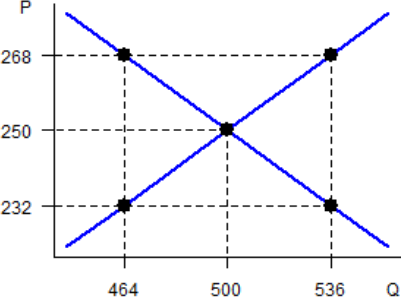
32. Suppose the government decides to set a rent ceiling of $232 per month. With this price ceiling, the minimum possible deadweight loss is $[ Answer32 ].
33. Continue with the $232 price ceiling. Consider two alternative ways of allocating the apartments when a shortage is present: bribery and waiting in line. Assume the per-unit cost of waiting time is same for all buyers, then the difference between the total social welfares under the two scenarios is $[ Answer33 ].
34. Assume that the consumption is automatically allocated to the highest-valuation consumers. The consumer surplus after the price ceiling is enforced is $[ Answer34 ].
Consider the market for the automatic sprinkler system. The supply and demand are summarized by the following equations.
Demand: Q = 430 − 2P
Supply: Q = 4P − 20
The installation of an automatic sprinkler system would provide benefit to other people in society as it reduces the risk of a fire spreading to nearby houses. Suppose the consumption/installation of an automatic sprinkler system brings to the society an external benefit of 12 dollars per automatic sprinkler system.
35. The unregulated market equilibrium quantity is [ Answer35A ] unit(s) of automatic sprinkler system. The unregulated market equilibrium price is [ Answer35B ] dollars per unit.
36. The total welfare for society at the unregulated market equilibrium is [ Answer36 ] dollars.
37. How many of the following statements are correct?
(I) Consider the case with zero external benefit and positive external cost. If the amount of the subsidy imposed equals the marginal external cost of the activity, then the market will end up with production and consumption at the socially efficient level.
(II) Patients wearing facemasks while in hospital create an external benefit.
(III) The Coase theorem says we will be able to achieve social optimal outcome as long as the property rights are well-defined.
A) 0
B) 1
C) 2
D) 3
[ Answer37 ]
As is demonstrated in the following table, two firms, X and Y, have access to five different production processes. Each process has a different cost ($) and gives off a different amount of pollution.
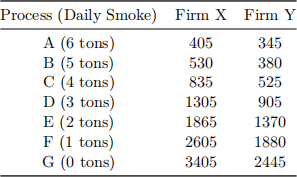
38. Originally, the pollution is unregulated, and negotiation between the firms and their victims is impossible. So the total pollution is [ Answer38A ] tons / day and the total cost of production for the two firms together is $[ Answer38B ].
39. If the government sets a tax on each ton of pollution emitted each day to cut the total pollution by 4 tons, then relative to the unregulated case, the tax should be at least $[ Answer39A ] /ton and at most $[ Answer39B ] /ton.
40. With the reduction of the 4 tons of pollution by taxation, the total production cost of the two firms will be $[ Answer40 ] /day.
41. If the government issues tradable pollution permits to the two firms to cut the total pollution by 4 tons (say, permits of 4 tons for each firm), and the firms can negotiate costlessly with each other, then relative to the unregulated case, the total production cost of the two firms will be $[ Answer41 ] /day.
42. Using pollution permits as a tool to reduce pollution by 4 tons, the cost of reducing the pollution to the society is $[ Answer42 ] /day.
43. Suburb A has a high burglary rate and they are considering the installation of anti-theft alarms. Each resident is willing to pay $50 for each additional anti-theft alarm installed in the suburb. There are 120 residents in the suburb. The marginal cost of installing another anti-theft alarm is 100y, where y is the number of anti-theft alarm. The socially efficient number of anti-theft alarms to be installed in this suburb is [ Answer43 ].
There are 9 residents in a village. Each of them can earn an income by making pottery or by hunting wild deer. The amount of wild deer in the nearby forest is limited. Therefore, the income each resident earns from hunting wild deer decreases with the number of residents who choose to hunt. If there are N residents hunting in the forest (N must be an integer), then each resident earns income Y = 65 − 4N. Alternatively, a resident can earn $32 if he or she chooses to make pottery.
44. Suppose each resident individually decides whether to hunt wild deer or to make pottery. [ Answer44 ] residents will choose to hunt wild deer.
45. Suppose the residents make decisions together to maximize the total income of the village, [ Answer45 ] residents will hunt wild deer.
46. Suppose the residents make decisions together to maximize the total income of the village, the total income of the village is $[ Answer46 ].
47. Suppose whoever wants to hunt wild deer in the forest is required by law to obtain a hunting license with the license fee $T payable to the village government. To help maximize the village’s total income, the license fee $T should be strictly larger than [ Answer47A ] and smaller than [ Answer47B ].
48. Consider the case without the license fee. Suppose now the village elects a leader, Nick, and he can allocate the residents in order to maximize the total income of the village. [ Answer48 ] residents will be allocated to hunt deer.
49. Suppose Andy’s and Ben’s marginal benefits (in dollars) from a neighborhood water fountain are given as follows:
Andy: MB = 45 − 0.5Q
Ben: MB = 35 − 0.2Q
where Q denotes the diameter of the fountain (in meters) to be installed.
Suppose that Q = 12m, the marginal benefit of an additional unit of the diameter of the fountain to the society is [ Answer49 ] dollars.
Consider two firms in a competitive market. The following table shows the marginal costs ($) of the two firms.
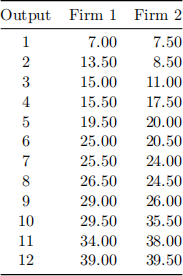
50. If the equilibrium price is higher than or equal to $[ Answer50A ] and strictly less than $[ Answer50B ], the two firms will produce a total of 8 units and the allocation of production will be efficient.
51. When firms 1 and 2 produce a total of 8 units, the socially optimal quantities produced by firm 1 is [ Answer51A ] unit(s) and firm 2 [ Answer51B ] unit(s).
52. Assume that the two firms A and B are in two isolated markets. The total cost functions of both firms are shown below:
Firm A’s total costs = $(165 + 4Q)
Firm B’s total costs = $(195 + 4Q)
where Q is the quantity produced.
Suppose that both firms face the identical demand function, that they are both pursuing a profit maximization policy, and that both firms are earning positive economic profits. Compared with firm A, firm B produce ______, and have ______ profits and ______ producer surplus.
A) the same quantity; the same amount of; the same size of
B) the same quantity; lower; the same size of
C) the same quantity; higher; the same size of
D) more; higher; larger
E) less; lower; smaller
F) Not enough information to answer this question.
[ Answer52 ]
A perfectly competitive market is initially in a long run equilibrium, with n identical firms (n can take non-integer values). The demand curve and the short-run supply curve are given as follows.
Supply: Q = 2P − 1 thousand units
Demand: Q = 1800 − 4P thousand units
53. The equilibrium price is [ Answer53A ] dollars per unit and the equilibrium quantity is [ Answer53B ] thousand units.
54. Suppose there is an increase in demand such that each consumer’s willingness to pay increases by 100 dollars, and suppose this is a constant cost industry. Then, the quantity traded in the market is [ Answer54 ] thousand units when the market reaches a long run equilibrium again.
55. Continue with the previous question. Suppose the new entrants and the incumbent firms are all identical. After the increase in demand, 10 new firms eventually enter the market so that a new long run equilibrium is reached. The average cost curve of an individual firm is minimized at q = [ Answer55 ] thousand units.
56. The average cost at this quantity is [ Answer56 ] dollars per unit.
Consider a constant cost industry producing good X. Initially, we are in a long-run equilibrium. The market equilibrium price is P0, the market equilibrium quantity is Q0, there are n0 firms. Individual firms each produces q0 and earn a profit of π0. Now suppose there is a decrease in demand. We would expect:
57. In the short run, the number of firms (n1) will be the same as n0.
The price of good X (P1) will be [ Answer57A ] P0.
Individual firm’s production (q1) will be [ Answer57B ] q0.
Individual firm’s profit (π1) will be [ Answer57C ] π0.
A. higher than B. lower than C. the same as
58. In new long-run equilibrium,
The price of X (P2) will be [ Answer58A ] P1, and be [ Answer58B ] P0.
Individual firm’s production (q2) will be [ Answer58C ] q1, and be [ Answer58D ] q0.
Individual firm’s profit (π2) will be [ Answer58E ] π1, and be [ Answer58F ] π0.
A. higher than B. lower than C. the same as
59. In new long-run equilibrium, the number of firms (n2) will be [ Answer59 ] n0.
A. larger than B. smaller than C. the same as
Your mom is the monopoly supplier of jokes in (humorless) Ho Hum. She faces a demand curve and a marginal cost curve given by following equations
Demand: Q = 86 − 0.17P jokes per day
Marginal Cost: MC = 80 dollars per joke
Assume that jokes are perfectly divisible.
60. Your profit-maximizing mom would produce [ Answer60A ] jokes per day, and set a price of [ Answer60B ] dollars per joke.
61. The price elasticity of demand at the profit-maximizing quantity is [ Answer61 ]
62. The markup at the profit-maximizing quantity is [ Answer62 ] percent.
63. The socially efficient quantity is [ Answer63 ] jokes.
64. Compared to the socially efficient quantity, monopoly pricing leads to a deadweight loss of [ Answer64 ] dollars per day.
A monopolist faces a demand curve of P = 80 − 0.5Q and has a constant marginal cost of $1. Assume that Q is perfectly divisible.
65. To maximize profit, the monopolist produces [ Answer65A ] units and charges [ Answer65B ] dollars.
66. If the government imposes a price ceiling at $2, the monopolist will produce [ Answer66 ] units.
67. At this price ceiling, the deadweight loss [ Answer67A ] (A. increases; B. decreases) by [ Answer67B ] dollars compared to an unregulated market.
68. At this price ceiling, the monopolist will not exit the market in the long run if the fixed cost is [ Answer68A ] (A. more; B. less) than [ Answer68B ] dollars.
69. An ice-cream shop is deciding how best to sell chocolate and vanilla soft-serve. The shop can either sell chocolate and vanilla separately in two small cups, or bundle them in one large cup with both flavors swirled together. Suppose the cost of supplying the soft-serve is zero. There are two customers in the market, and their willingness to pay for each flavor is summarized in the table below.

The shop can make a profit of [ Answer69 ] dollars.
Consider Uncle Fong who sells salted fish at a fishing village. The cost of a salted fish is $355. On a normal day, Uncle Fong expects to see 10 tourists with the following reservation prices for the salted fish.
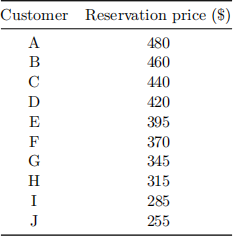
70. If Uncle Fong has to charge the same price for all the salted fish he sells, to maximize profit, it will charge $[ Answer70A ] per unit and sell to [ Answer70B ] visitors, and consequently make a profit of [ Answer70C ].
71. Suppose Uncle Fong does not know each buyer’s reservation price but he knows that all buyers with a reservation price above $355 never use discount coupons. Those with reservation prices below $355 use them whenever they are available. If Uncle Fong makes coupons available in the government tourist magazine, those buyers who clip and present them get to pay a discounted price for salted fish. Others pay the regular list price. To maximize profit, Uncle Fong should set the list price at $[ Answer71A ] per unit and the discount price at $[ Answer71B ] per unit.
72. With coupons, Uncle Fong will sell to [ Answer72A ] visitors in total, and consequently make a profit of [ Answer72B ] in total.
73. Miss Chan Chan is a monopoly selling widgets in city A. She faces a demand curve and a marginal cost curve given by the following equations.
Demand: P = 75 − 0.5Q
Marginal Cost: MC = 5Q
Suppose Miss Chan Chan can implement perfect price discrimination. Using this information, we can compute that the total consumer surplus in this market is [ Answer73A ] and the deadweight loss in this market is [ Answer73B ].
2023-07-13